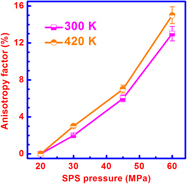Crossref Citations
This article has been cited by the following publications. This list is generated based on data provided by
Crossref.
Hu, L.P.
Liu, X.H.
Xie, H.H.
Shen, J.J.
Zhu, T.J.
and
Zhao, X.B.
2012.
Improving thermoelectric properties of n-type bismuth–telluride-based alloys by deformation-induced lattice defects and texture enhancement.
Acta Materialia,
Vol. 60,
Issue. 11,
p.
4431.
Prokhorov, V M
Pivivarov, G I
Levin, V M
and
Morokov, E S
2012.
Internal cracks distribution in hot-pressed and spark plasma sintered nanostructured Bi2Te3-based thermoelectrics: acoustic microscopy versus optical microscopy.
IOP Conference Series: Materials Science and Engineering,
Vol. 42,
Issue. ,
p.
012003.
Xie, Wenjie
Wang, Shanyu
Zhu, Song
He, Jian
Tang, Xinfeng
Zhang, Qingjie
and
Tritt, Terry M.
2013.
High performance Bi2Te3 nanocomposites prepared by single-element-melt-spinning spark-plasma sintering.
Journal of Materials Science,
Vol. 48,
Issue. 7,
p.
2745.
Lu, Pengfei
Wu, Chengjie
Li, Yiluan
Yu, Zhongyuan
Cao, Huawei
Gao, Tao
and
Wang, Shumin
2013.
A theoretical investigation on thermoelectric performance of ternary (Bi1−x Sb x )2Te3 compound.
Journal of Materials Science,
Vol. 48,
Issue. 14,
p.
4999.
Puneet, Pooja
Podila, Ramakrishna
Karakaya, Mehmet
Zhu, Song
He, Jian
Tritt, Terry M.
Dresselhaus, Mildred S.
and
Rao, Apparao M.
2013.
Preferential Scattering by Interfacial Charged Defects for Enhanced Thermoelectric Performance in Few-layered n-type Bi2Te3.
Scientific Reports,
Vol. 3,
Issue. 1,
Saucke, Gesine
Populoh, Sascha
Vogel-Schäuble, Nina
Sagarna, Leyre
Mogare, Kailash
Karvonen, Lassi
and
Weidenkaff, Anke
2013.
Thermoelectric properties of Ru and In substituted misfit-layered Ca3Co4O9.
MRS Proceedings,
Vol. 1543,
Issue. ,
p.
83.
Saleemi, M.
Ruditskiy, A.
Toprak, M. S.
Stingaciu, M.
Johnsson, M.
Kretzschmar, I.
Jacquot, A.
Jägle, M.
and
Muhammed, M.
2014.
Evaluation of the Structure and Transport Properties of Nanostructured Antimony Telluride (Sb2Te3).
Journal of Electronic Materials,
Vol. 43,
Issue. 6,
p.
1927.
Kitagawa, Hiroyuki
Nagao, Kojiro
Mimura, Naoki
Morito, Shigekazu
and
Kikuchi, Kotaro
2014.
Preparation of Bi0.5Sb1.5Te3 Thermoelectric Materials by Pulse-Current Sintering Under Cyclic Uniaxial Pressure.
Journal of Electronic Materials,
Vol. 43,
Issue. 6,
p.
1574.
Hu, Li-Peng
Zhu, Tie-Jun
Wang, Ya-Guang
Xie, Han-Hui
Xu, Zhao-Jun
and
Zhao, Xin-Bing
2014.
Shifting up the optimum figure of merit of p-type bismuth telluride-based thermoelectric materials for power generation by suppressing intrinsic conduction.
NPG Asia Materials,
Vol. 6,
Issue. 2,
p.
e88.
Hu, Lipeng
Wu, Haijun
Zhu, Tiejun
Fu, Chenguang
He, Jiaqing
Ying, Pingjun
and
Zhao, Xinbing
2015.
Tuning Multiscale Microstructures to Enhance Thermoelectric Performance of n‐Type Bismuth‐Telluride‐Based Solid Solutions.
Advanced Energy Materials,
Vol. 5,
Issue. 17,
Liu, Zihang
Pei, Yanling
Geng, Huiyuan
Zhou, Jingchao
Meng, Xianfu
Cai, Wei
Liu, Weishu
and
Sui, Jiehe
2015.
Enhanced thermoelectric performance of Bi2S3 by synergistical action of bromine substitution and copper nanoparticles.
Nano Energy,
Vol. 13,
Issue. ,
p.
554.
Melnikov, A. A.
Tabachkova, N. Yu.
Kichik, S. A.
Marakushev, I. S.
Koryakin, A. N.
and
Ponomarev, V. F.
2015.
Influence of Temperature During Spark Plasma Sintering Compaction of Melt-Spun p-Bi0.5Sb1.5Te3.
Journal of Electronic Materials,
Vol. 44,
Issue. 6,
p.
1517.
Hu, L.P.
Zhu, T.J.
Yue, X.Q.
Liu, X.H.
Wang, Y.G.
Xu, Z.J.
and
Zhao, X.B.
2015.
Enhanced figure of merit in antimony telluride thermoelectric materials by In–Ag co-alloying for mid-temperature power generation.
Acta Materialia,
Vol. 85,
Issue. ,
p.
270.
Yang, Jingjing
Wu, Fang
Zhu, Zheng
Yao, Lan
Song, Hongzhang
and
Hu, Xing
2015.
Thermoelectrical properties of lutetium-doped Bi2Te3 bulk samples prepared from flower-like nanopowders.
Journal of Alloys and Compounds,
Vol. 619,
Issue. ,
p.
401.
Tang, Zhenglong
Hu, Lipeng
Zhu, Tiejun
Liu, Xiaohua
and
Zhao, Xinbing
2015.
High performance n-type bismuth telluride based alloys for mid-temperature power generation.
Journal of Materials Chemistry C,
Vol. 3,
Issue. 40,
p.
10597.
Zhang, Yuewen
Jia, Xiaopeng
Sun, Hairui
Sun, Bing
Liu, Binwu
Liu, Haiqiang
Kong, Lingjiao
and
Ma, Hongan
2016.
Enhanced thermoelectric performance of nanostructured CNTs/BiSbTe bulk composite from rapid pressure-quenching induced multi-scale microstructure.
Journal of Materiomics,
Vol. 2,
Issue. 4,
p.
316.
Zheng, Gang
Su, Xianli
Li, Xinran
Liang, Tao
Xie, Hongyao
She, Xiaoyu
Yan, Yonggao
Uher, Ctirad
Kanatzidis, Mercouri G.
and
Tang, Xinfeng
2016.
Toward High‐Thermoelectric‐Performance Large‐Size Nanostructured BiSbTe Alloys via Optimization of Sintering‐Temperature Distribution.
Advanced Energy Materials,
Vol. 6,
Issue. 13,
Yao, L.
Wu, F.
Wang, X. X.
Cao, R. J.
Li, X. J.
Hu, X.
and
Song, H. Z.
2016.
Effects of Thallium Doping on the Transport Properties of Bi2Te3 Alloy.
Journal of Electronic Materials,
Vol. 45,
Issue. 6,
p.
3053.
Lin, Hua
Tan, Gangjian
Shen, Jin‐Ni
Hao, Shiqiang
Wu, Li‐Ming
Calta, Nicholas
Malliakas, Christos
Wang, Si
Uher, Ctirad
Wolverton, Christopher
and
Kanatzidis, Mercouri G.
2016.
Concerted Rattling in CsAg5Te3 Leading to Ultralow Thermal Conductivity and High Thermoelectric Performance.
Angewandte Chemie,
Vol. 128,
Issue. 38,
p.
11603.
Lin, Hua
Tan, Gangjian
Shen, Jin‐Ni
Hao, Shiqiang
Wu, Li‐Ming
Calta, Nicholas
Malliakas, Christos
Wang, Si
Uher, Ctirad
Wolverton, Christopher
and
Kanatzidis, Mercouri G.
2016.
Concerted Rattling in CsAg5Te3 Leading to Ultralow Thermal Conductivity and High Thermoelectric Performance.
Angewandte Chemie International Edition,
Vol. 55,
Issue. 38,
p.
11431.





